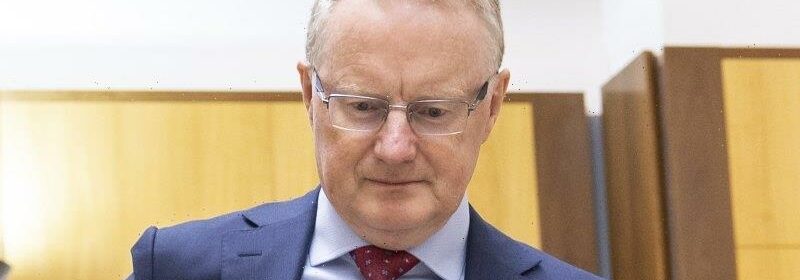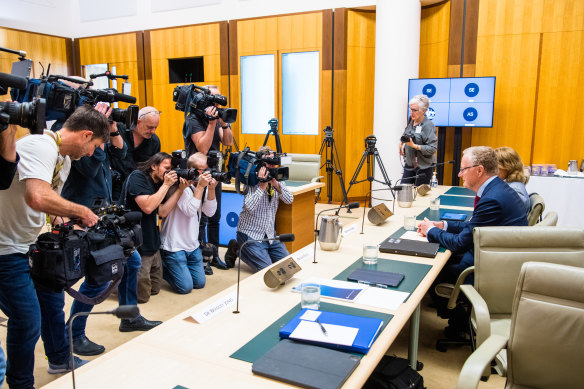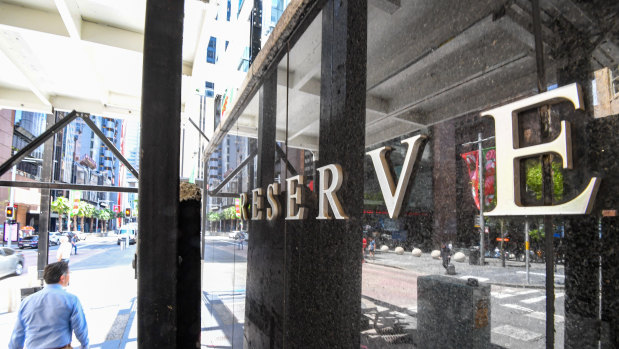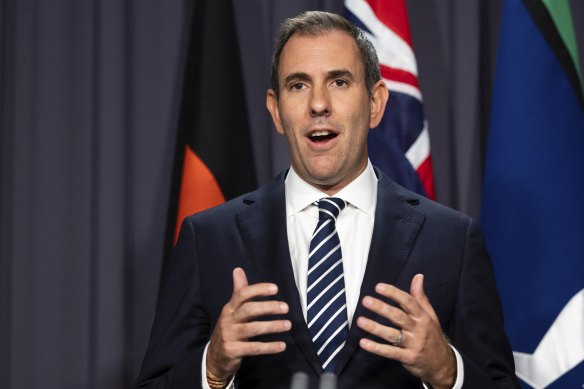Five hours of questions – but just one mattered for RBA boss Phil Lowe

Reserve Bank governor Philip Lowe spent the best part of five hours this week being questioned by politicians about interest rates and the state of the economy.
But the entire five hours could be summed up by a single question from the Greens’ economic justice spokesman, Nick McKim, who nailed the issues floating around Lowe and the RBA.
Phil LoweCredit:James Brickwood
“You seem prepared to smash Australia into a recession by trying to squash demand in response to inflation that has, on the RBA’s own analysis, been predominantly a result of supply-side factors,” he said to Lowe on Wednesday morning.
“Can you explain to the renters and mortgage-holders of Australia why you still deserve to hold your job?”
Lowe did not bite on what may be the first time an RBA governor has been told to resign during a Senate estimates hearing, but he did push back at the suggestion the bank is planning to upend the economy.
“Can I assure you that’s not our intention. We are trying to navigate a narrow path. We want to get inflation down because it’s dangerous. It’s corrosive, it hurts people. It damages income inequality,” he replied.
For the first time, a Reserve Bank governor faced two separate parliamentary hearings within two days. The issue at the top of mind was the bank’s decision to lift interest rates at its past nine board meetings, and a change in language implying more rate rises ahead.
A combination of factors – the most indebted households in the developed world with some of the largest mortgages on the planet, the highest inflation rate in a generation, the lowest unemployment rate in 50 years, and previous missteps by the RBA itself – all meant the Reserve’s actions have driven community concern unlike anything since the late 1980s.
Lowe, the public face of the bank with a seven-year term due to end in September, has borne the brunt of that community concern.
McKim’s question went to the heart of the issue playing out across the nation’s suburbs, in its shopping centres, and around the cash registers of Australia’s small and medium-sized businesses.
Less than a year ago, the official cash rate was 0.1 per cent. A few months earlier, Lowe had told the community interest rates were likely to remain at the same level until 2024.
But surging inflation, driven primarily by the war in Ukraine and supply-chain issues across the world, ended that scenario.
Millions of borrowers – be it for mortgages or businesses – are now feeling the twin hit of higher inflation and the impact of those higher interest rates. In pure dollar terms, the RBA’s rate increases have lifted the monthly repayments on an average $604,000 mortgage by more than $1100.
Over a year, and even without any more rate increases, that would be a $13,200 hit to a household’s income. KPMG Australia chief economist Brendan Rynne estimates that’s a $20 billion cut in spending across the economy.
Lowe admitted the bank’s tightening of monetary policy is the key reason it is expecting economic growth to slow to just 1.5 per cent this year and next. Once you factor in population growth, that’s two years of zero growth.
It’s also the reason the bank believes unemployment, which lifted to 3.7 per cent in January, is on its way to 4.5 per cent by mid-2025.
Beyond these high level numbers, RBA assistant governor Brad Jones gave some hint of the pain already being caused by the bank’s actions.
While noting about half the people with variable rate mortgages are more than a year ahead on their repayments, he said there’s 10 per cent who effectively have no cash left over after paying the mortgage and groceries.
“There’s no question that there’s a segment of the community that are hurting now and that’s very likely to continue,” he noted on Friday.
As Lowe mentioned often to all MPs, the RBA’s job is to keep inflation between two and three per cent, and it can only do that by moving interest rates up and down.
“The instrument that we have to achieve this is interest rates, which, I acknowledge, can be a blunt instrument.”
The nation’s major lenders have all revised upward their expectations about where the RBA will take the official cash rate.
Both the NAB and ANZ reckon it will reach 4.1 per cent by May.
ANZ economists Felicity Emmett, Adelaide Timbrell and Catherine Birch said current rate rises had still to really bite.
“Nearly 70 per cent of mortgage debt has already been impacted by higher variable rates, and to date there is little evidence of a material impact on overall spending,” they said.
The nation’s two largest home lenders, Westpac and the Commonwealth, reckon 3.85 per cent will be enough to bring inflation to heel.
Westpac revealed on Friday that about half of its $471 billion in home loans were written with interest rate buffers that are likely to be exceeded. No one, even within the Reserve Bank, is exactly sure how all these people are going to deal with such high mortgage rates.
The CBA’s head of Australian economics, Gareth Aird, believes the Reserve will quickly discover they have tightened monetary policy too much.
“We think that the RBA is underestimating the lagged impact that the already delivered interest rate hikes will have on the economy in 2023,” he said.
“It takes time for rate hikes to impact home-borrower cash flow and by extension, spending decisions. And far more borrowers than usual are on fixed-rate mortgages, which blunts the initial impact of rate rises.”
All the to-ing and fro-ing between Lowe and politicians was being played out against the backdrop of the first independent review of the Reserve Bank since 1980. That review, which will recommend changes to the bank’s operation, is due to report on March 31.
The RBA, the last major central bank in the world to undergo an outside investigation, is unusual among its peers in the way the board charged with deciding interest rate settings is largely made up of “amateurs”.
Unlike many other central banks, the board charged with setting monetary policy in Australia is largely made up of non-economists.Credit:Peter Rae
Lowe, his deputy Michele Bullock and Treasury secretary Steven Kennedy are three of the board’s nine members. The rest are appointees largely drawn from the business community.
As Lowe this week made clear on a number of occasions, it’s not just him deciding interest rates. But he is charged with being the RBA’s public face on rate decisions.
It’s in stark contrast to other central banks, which often have standalone committees of experts to set monetary policy (with the bank overseen by a separate board).
Hours before Lowe made his second parliamentary performance, the chief economist of the Bank of England (BoE), Huw Pill, delivered a speech the like of which you would not hear from an ordinary member of the RBA board.
Pill, who sits on the BoE’s monetary policy setting committee, delivered a speech entitled “Inflation is a Wicked Problem”, in which he made his case for higher interest rate settings in Britain. It was the fourth speech this year by a BoE expert on monetary policy.
By contrast, Lowe this week faced questions over why he decided against giving an “economic year ahead” speech, as he has done for the past four years.
Lowe argued he had received feedback from at least one person that perhaps he spoke in public too much and that it was better to answer questions directly from MPs at his appearance before the House of Representatives’ economics committee.
While not speaking in public, Lowe did hold a private function on the Thursday after the RBA’s February 7 rate rise with trading bankers at an event with financial services firm Barrenjoey.
Treasurer Jim Chalmers will receive the report of the Reserve Bank’s independent review on March 31.Credit:Alex Ellinghausen
Lowe expressed displeasure that news of his Barrenjoey appearance had leaked, but defended his actions in holding a private event.
“I can’t live in a bubble. I need to talk to people. I need to hear what financial markets say and I like asking people questions,” he said.
After the cumulative five hours of questioning, Lowe had made a number of clear points: inflation remains the RBA’s number one target; he understands the pain being felt by those paying more on their mortgages; and unemployment is likely to lift, but not by much.
People may not like what the RBA is doing, but it’s doing its best.
“I’ve got to do the job I’ve been assigned to do – and that is to get inflation back down, hopefully keep the economy on the narrow path, and the tool I have to use is interest rates and we’re going to keep using it,” he said.
Cut through the noise of federal politics with news, views and expert analysis from Jacqueline Maley. Subscribers can sign up to our weekly Inside Politics newsletter here.
Most Viewed in Politics
From our partners
Source: Read Full Article


